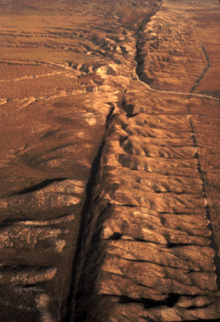
Back صدع نشط Arabic Falla activa Spanish گسل فعال Persian Sesar aktif ID 活断層 Japanese 활성단층 Korean Активный разлом Russian Active fault SIMPLE Активни расед Serbian Diri fay Turkish

An active fault is a fault that is likely to become the source of another earthquake sometime in the future. Geologists commonly consider faults to be active if there has been movement observed or evidence of seismic activity during the last 10,000 years.[1]
Active faulting is considered to be a geologic hazard – one related to earthquakes as a cause. Effects of movement on an active fault include strong ground motion, surface faulting, tectonic deformation, landslides and rockfalls, liquefaction, tsunamis, and seiches.[2]
Quaternary faults are those active faults that have been recognized at the surface and which have evidence of movement during the Quaternary Period.[3]
Related geological disciplines for active-fault studies include geomorphology, seismology, reflection seismology, plate tectonics, geodetics and remote sensing, risk analysis, and others.[2]
- ^
"Active fault" (online web page). Earthquake Glossary. USGS Earthquake Hazards Program. November 3, 2009. Retrieved 2011-09-17.
 This article incorporates public domain material from websites or documents of the United States Geological Survey.
This article incorporates public domain material from websites or documents of the United States Geological Survey.
- ^ a b Cite error: The named reference
slemonswas invoked but never defined (see the help page). - ^ Cite error: The named reference
relatewas invoked but never defined (see the help page).